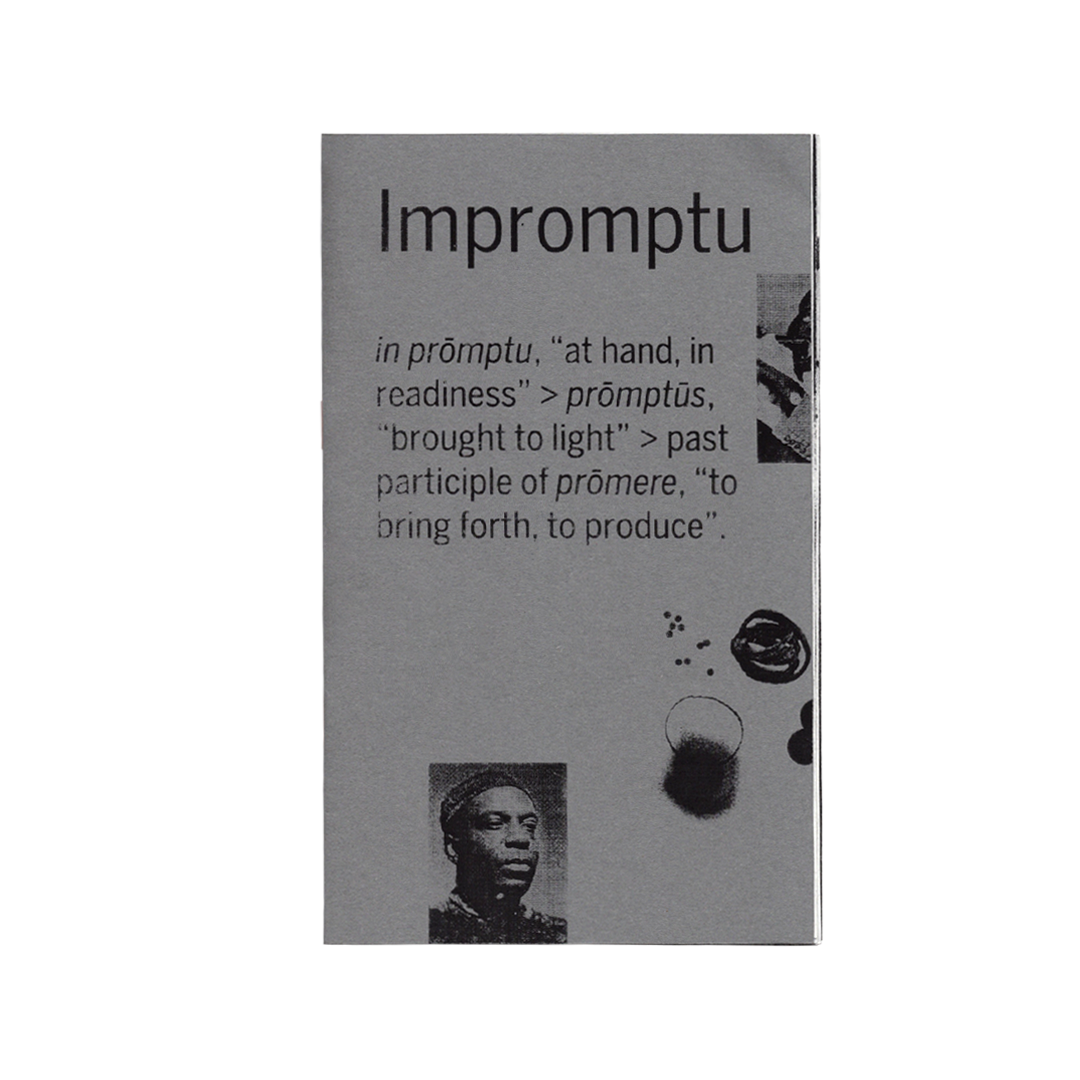
Impromptu, Visual Essay
Graphic Design: Thomas & Jurgen
Originally published as a copyzine. Limited edition of 100 copies, printed on 80 grs. Cyclus offset recycled paper and produced on a Canon Copier GP160.
After being asked ‘What is jazz?’, Louis Armstrong replied, ‘Man, if you have to ask, you’ll never know’︎. His celebrated (and denounced) answer casually expressed the seemingly undefinable nature of jazz, its inability to be tied down to one fixed frame of characteristics. An elusiveness that is inextricably linked to its improvisatory form.
Constructed by the Latin words pro ('in advance'), visus ('to see') and the prefix im- ('not'), improvisation embodies the unforeseen, the unexpected or that which occurs ‘on the spur of the moment’. This idea of something that arises from a fleeting moment can also be found in the synonym for improvisation, extemporisation, which both means ‘outside of time’ and ‘from the time’.
An improvisation is often described as a momentum outside daily reality, in which time seems to freeze and fly. The improviser constantly switches between transforming what is, and anticipating what is to come. By playing, the present tense is stretched, responded to it in retrospect. Thinking and acting are forced to go hand in hand.
Constructed by the Latin words pro ('in advance'), visus ('to see') and the prefix im- ('not'), improvisation embodies the unforeseen, the unexpected or that which occurs ‘on the spur of the moment’. This idea of something that arises from a fleeting moment can also be found in the synonym for improvisation, extemporisation, which both means ‘outside of time’ and ‘from the time’.
An improvisation is often described as a momentum outside daily reality, in which time seems to freeze and fly. The improviser constantly switches between transforming what is, and anticipating what is to come. By playing, the present tense is stretched, responded to it in retrospect. Thinking and acting are forced to go hand in hand.
︎ Louis Armstrong, quoted in Jazz 101: A Complete Guide to Learning and Loving Jazz by John F. Szwed, 2000.
Keith Johnstone, pioneer of improvisational theatre, once described the improviser as a man walking backwards: ‘He sees where he has been, but he pays no attention to the future.’︎ Looking back while moving forward, the improviser surrenders fully to the reality of time's flow. Psychologist Mihaly Csikscentmihalyi introduced the experience of this flow as:
︎Keith Johnstone in Impro: Improvisation and the Theatre. New York: Theatre Arts Books, 1979.
“[the] holistic sensation present when we act with total involvement. [...] We experience it as a unified flowing from one moment to the next, in which we feel in control of our actions, and in which there is little distinction between self and environment; between stimulus and response; or between past, present and future.”︎
︎ Mihaly Csikscentmihalyi in Finding Flow: The psychology of engagement with everyday life. New York: Harper Collins, 1980.
Flow as a state of being or, in the relation to jazz, a state of being played. A setting in which the performer observes their own fingers move over the instrument, and in which every movement or sound follows inevitably from the previous one. It’s a concentrated search for the aesthetics of presence, of being there. Playing for the sake of playing.

The experience of this prolonged now is build upon the remembrance of things past. The improviser doesn’t just pick up an instrument and plays whatever comes to mind, but falls back on learned procedures, skills and standards. Despite its name, improvised jazz is based on a framework of laws, on the remodelling of existing materials, traditions and knowledge.
An improvised sentence is like a rephrased quotation, shaped and transformed under the special conditions of performance. On stage, the learned and the lived are destined to meet in the middle. To get a completely improvised feel across, the improviser embraces what they know, “a pattern so complex that we get an illusion of randomness”︎. Only trained cats can uphold this air of nonchalance.
︎Stephen Nachmanovitch in Free play: improvisation in life and art, G.P. Putnam's Sons, 1990.
According to the author Julio Cortázar, who’s work was heavily influenced by improvisatory techniques, a good short story relies “on those values that make poetry and jazz what they are: tension, rhythms, inner beat, into unforeseen within foreseen parameters”︎. An improvisation is born out of these parameters, mutually agreed upon by all its players.
︎ Julio Cortázar in ‘On the Short Story and its Environs’, The Review of Contemporary Fiction, 3, 1983.

These players are trying to keep a conversation going, figuring out their thoughts while speaking to each other.
It takes two to know one. Without the other, the improviser follows his own sensual and intellectual thinking process. In presence of the other, he has to deal with the unforeseen, forced to respond to unexpected calls. He has to learn to enjoy not having an answer prepared, to be at ease with not knowing.
To improvise, is to move between the known and the unknown. It sits on the edge and, like saxophonist Steve Lacy put it, “you have to keep pushing it towards the unknown otherwise it and you die”.︎ This demands a readiness for the new, while repeating the old in endless variation. A preparation for things that are not there yet, while continuously producing work at hand.
︎Steve Lacy, quoted in Derek Bailey’s Improvisation: Its nature and Practice in Music Derbyshire: Moorland Publishing, 1980
Sun Ra said “somewhere on the other side of nowhere, there's another place.”︎ Improvisation is a search for that other place, in which time shrinks to to a sequence of now-now-now, or now-here, or nowhere.
Over and over again.
Over and over again.
︎Sun Ra, quoted in the documentary Sun Ra: A Joyful Noise, directed by Robert Mugge, 1980
